Examination of Nesting Behavior of Laying Hens of Different Genotypes Housed in Indoor Alternative Pens Using a Video System
Abstract
:1. Introduction
2. Materials and Methods
- Commercial brown layer hybrid (C);
- Purebred paternal offspring group (Paternal);
- Purebred maternal offspring group (Maternal).
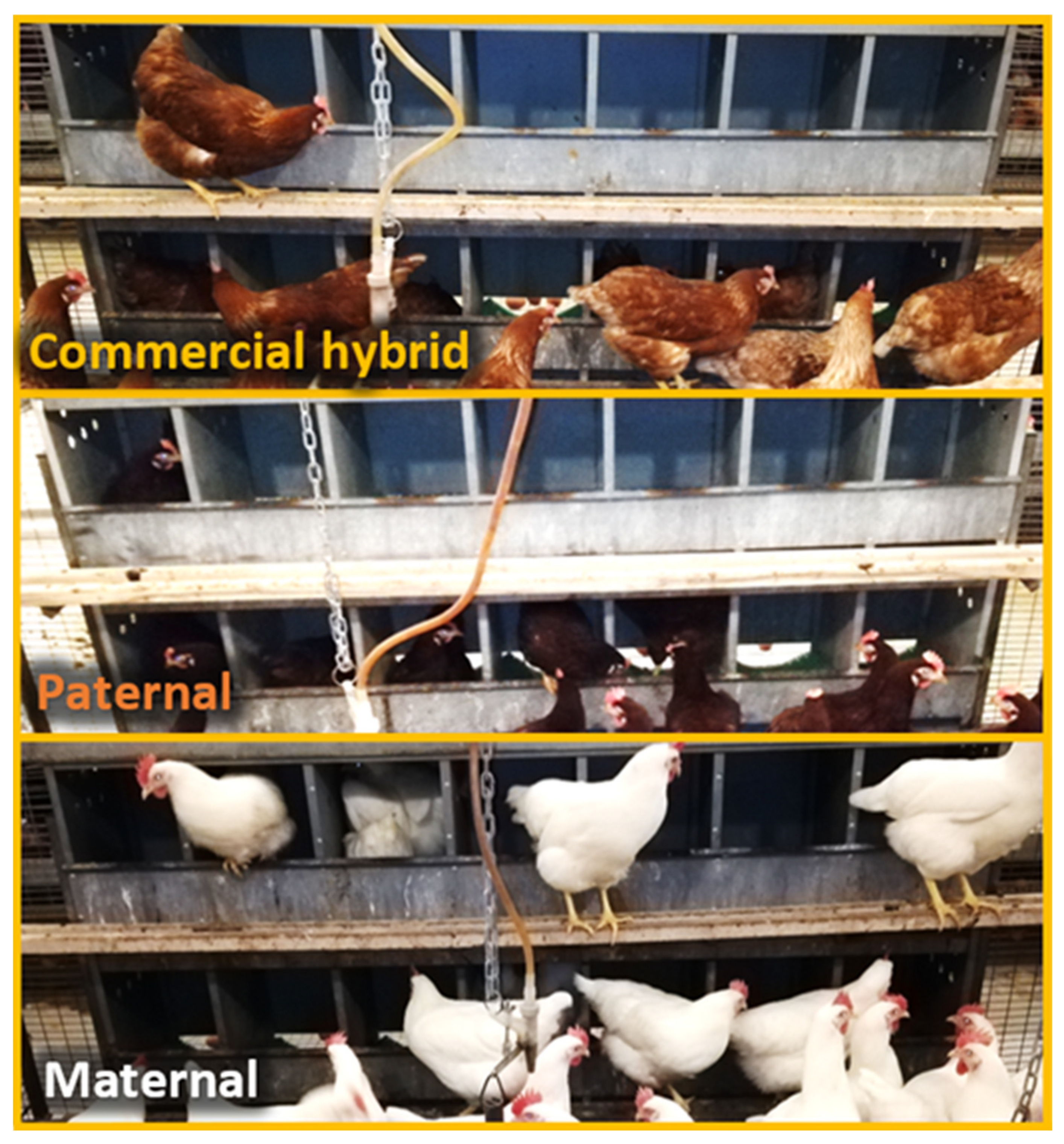
3. Results and Discussion
3.1. Proportion of Eggs Laid in Nests and in Litter
3.2. The Preference of Laying Hens between Nests Located on the Lower and Upper Levels
3.3. Number of Times Laying Hens Visited the Nest Based on Video Evaluation
3.4. Duration of Nest Visits of the Laying Hens Based on Video Evaluation
4. Conclusions
Author Contributions
Funding
Institutional Review Board Statement
Informed Consent Statement
Data Availability Statement
Acknowledgments
Conflicts of Interest
References
- Farkas, T.P.; Orbán, A.; Szász, S.; Rapai, A.; Garamvölgyi, E.; Sütő, Z. Examination of the Usage of a New Beak-Abrasive Material in Different Laying Hen Genotypes (Preliminary Results). Agriculture 2021, 11, 947. [Google Scholar] [CrossRef]
- Directives Originating from the EU. Council Directive 1999/74/EC of 19 July 1999 laying down minimum standards for the protection of laying hens. Off. J. Eur. Communities 1999, L203, 53–57. [Google Scholar]
- Lay, D.C.; Fulton, R.M.; Hester, P.Y.; Karcher, D.M.; Kjaer, J.B.; Mench, J.; Mullens, B.A.; Newberry, R.C.; Nicol, C.J.; O’Sullivan, N.P.; et al. Hen welfare in different housing systems. Poult. Sci. 2011, 90, 278–294. [Google Scholar] [CrossRef] [PubMed]
- Yue, S.; Duncan, I.J.H. Frustrated nesting behaviour: Relation to extra-cuticular shell calcium and bone strength in White Leghorn hens. Br. Poult. Sci. 2003, 44, 175–181. [Google Scholar] [CrossRef]
- Stämpfli, K.; Roth, B.A.; Buchwalder, T.; Fröhlich, E.K.F. Influence of nest-floor slope on the nest choice of laying hens. Appl. Anim. Behav. Sci. 2011, 135, 286–292. [Google Scholar] [CrossRef]
- Sütő, Z. “End the cage age!” Európai kezdeményezés magyar tojástermelő ágazatra gyakorolt lehetséges hatásai. In Tanulmányok az Európai Unióban a Ketreces Tartás Jövőbeni Betiltásának Várható Következményeiről a Magyar Állatitermék-előállításra: Étkezésitojás-Termelés, Hízottbaromfi-Előállítás (Lúd, Kacsa), Nyúlhústermelés; Kaposvári Egyetem: Kaposvár, Hungary, 2020; pp. 8–42. [Google Scholar]
- Appleby, M.C.; McRae, H.E.; Peitz, B.E. The effect of light on the choice of nests by domestic hens. Appl. Anim. Ethol. 1984, 11, 249–254. [Google Scholar] [CrossRef]
- Villanueva, S.; Ali, A.B.A.; Campbell, D.L.M.; Siegford, J.M. Nest use and patterns of egg laying and damage by 4 strains of laying hens in an aviary system. Poult. Sci. 2017, 96, 3011–3020. Available online: https://www.sciencedirect.com/science/article/pii/S0032579119315032 (accessed on 1 March 2022). [CrossRef]
- Giersberg, M.F.; Kemper, N.; Spindler, B. Pecking and piling: The behaviour of conventional layer hybrids and dual-purpose hens in the nest. Appl. Anim. Behav. Sci. 2019, 214, 50–56. Available online: https://www.sciencedirect.com/science/article/abs/pii/S0168159118305938 (accessed on 1 March 2022). [CrossRef]
- Zomborszky, Z.; Budai, Z.; Milisits, G.; Szász, S.; Farkas, T.P.; Ujváriné, J.; Horn, P.; Sütő, Z. Eltérő genetikai hátterű, tojó típusú, csőrkurtítatlan jérce állomány nevelés alatti és tojóházi kiesésének elemző vizsgálata, különös tekintettel az agresszióra. In Proceedings of the XXI. Kaposvári Baromfitenyésztési Szimpózium, Kaposvár, Hungary, 29 September 2018; pp. 78–87. [Google Scholar]
- Sepeur, S.; Spindler, B.; Schulze-Bisping, M.; Habig, C.; Andersson, M.; Beyerbach, M.; Kemper, N. Comparison of plumage condition of laying hens with intact and trimmed beaks kept on commercial farms. Arch. Geflugelkd. 2015, 79. [Google Scholar] [CrossRef]
- Rodenburg, T.B.; Van Krimpen, M.M.; De Jong, I.C.; De Haas, E.N.; Kops, M.S.; Riedsrta, B.J.; Nicol, C.J. The prevention and control of feather pecking in laying hens: Identifying the underlying principles. Worlds Poult. Sci. J. 2013, 69, 361–373. [Google Scholar] [CrossRef]
- Niebuhr, K.; Zaludik, K.; Gruber, B.; Thenmaier, I.; Lugmair, A.; Troxler, J. Epidemiologische Unter-suchungen zum Auftreten von Kannibalismus und Federpicken in alternativen Legehennenhaltungen in Österreich. In Endbericht Forschungsprojekt; Nr. 1313 ITT; University Vienna: Vienna, Austria, 2006. [Google Scholar] [CrossRef]
- Hunniford, M.E.; Widowski, T.M. Curtained nests facilitate settled nesting behaviour of laying hens in furnished cages. Appl. Anim. Behav. Sci. 2018, 202, 39–45. Available online: https://www.sciencedirect.com/science/article/abs/pii/S0168159118300364 (accessed on 1 March 2022). [CrossRef]
- Krause, E.T.; Schrader, L. High, low, or familiar? Nest site preferences of experienced laying hens. Br. Poult. Sci. 2018, 59, 359–364. Available online: https://www.tandfonline.com/doi/full/10.1080/00071668.2018.1470318 (accessed on 1 March 2022). [CrossRef]
- Lundberg, A.; Keeling, L.J. The impact of social factors on nesting in laying hens (Gallus gallus domesticus). Appl. Anim. Behav. Sci. 1999, 64, 57–69. Available online: https://www.sciencedirect.com/science/article/abs/pii/S0168159199000209?via%3Dihub (accessed on 1 March 2022). [CrossRef]
- Appleby, M.C.; Mench, J.A.; Hughes, B.O. Poultry Behaviour and Welfare; CABI Publishing, Division of CAB International: Cambridge, UK, 2004; Volume 2, pp. 30–67. [Google Scholar]
- Appleby, M.C. Behaviour of laying hens in cages with nest sites. Br. Poult. Sci. 1990, 31, 71–80. Available online: https://www.tandfonline.com/doi/abs/10.1080/00071669008417232 (accessed on 1 March 2022). [CrossRef]
- Freire, R.; Appleby, M.C.; Hughes, B.O. Effects of nest quality and other cues for exploration on pre-laying behaviour. Appl. Anim. Behav. Sci. 1996, 48, 37–46. Available online: https://www.sciencedirect.com/science/article/abs/pii/0168159195010238 (accessed on 1 March 2022). [CrossRef]
- Engel, J.M.; Widowski, T.M.; Tilbrook, A.J.; Butler, K.L.; Hemsworth, P.H. The effects of floor space and nest box access on the physiology and behavior of caged laying hens. Poult. Sci. 2018, 98, 533–547. Available online: https://www.sciencedirect.com/science/article/pii/S0032579119305231 (accessed on 1 March 2022). [CrossRef]
- Meijsser, F.M.; Hughes, B.O. Comparative analysis of pre-laying behaviour in battery cages and in three alternative systems. Br. Poult. Sci. 1989, 30, 747–760. [Google Scholar] [CrossRef]
- Hunniford, M.E.; Torrey, S.; Bédécarrats, G.; Duncan, I.J.H.; Widowski, T.M. Evidence of competition for nest sites by laying hens in large furnished cages. Appl. Anim. Behav. Sci. 2014, 161, 95–104. Available online: https://www.sciencedirect.com/science/article/abs/pii/S0168159114002111?via%3Dihub (accessed on 1 March 2022). [CrossRef]
- Ringgenberg, N.; Fröhlich, E.K.F.; Harlander-Matauschek, A.; Würbel, H.; Roth, B.A. Does nest size matter to laying hens? Appl. Anim. Behav. Sci. 2014, 155, 66–73. Available online: https://www.sciencedirect.com/science/article/abs/pii/S0168159114000732 (accessed on 1 March 2022). [CrossRef]
- Clausen, T.; Riber, A.B. Effect of heterogeneity of nest boxes on occurrence of gregarious nesting in laying hens. Appl. Anim. Behav. Sci. 2012, 142, 168–175. Available online: https://www.sciencedirect.com/science/article/abs/pii/S0168159112003000?via%3Dihub (accessed on 1 March 2022). [CrossRef]
- Riber, A.B.; Nielsen, B.L. Changes in position and quality of preferred nest box: Effects on nest box use by laying hens. Appl. Anim. Behav. Sci. 2013, 148, 185–191. Available online: https://www.sciencedirect.com/science/article/abs/pii/S0168159113002086 (accessed on 1 March 2022). [CrossRef]
- Ringgenberg, N.; Fröhlich, E.K.F.; Harlander-Matauschek, A.; Toscano, M.J.; Würbel, H.; Roth, B.A. Nest choice in laying hens: Effects of nest partitions and social status. Appl. Anim. Behav. Sci. 2015, 169, 43–50. Available online: https://www.sciencedirect.com/science/article/abs/pii/S0168159115001276 (accessed on 1 March 2022). [CrossRef]
- Huber-Eicher, B. The effect of early colour preference and of a colour exposing procedure on the choice of nest colours in laying hens. Appl. Anim. Behav. Sci. 2004, 86, 63–76. Available online: https://www.sciencedirect.com/science/article/abs/pii/S0168159103003046 (accessed on 1 March 2022). [CrossRef]
- Cooper, J.J.; Appleby, M.C. Motivational aspects of individual variation in response to nestboxes by laying hens. Anim. Behav. 1997, 54, 1245–1253. Available online: https://www.sciencedirect.com/science/article/abs/pii/S0003347297905212 (accessed on 1 March 2022). [CrossRef] [Green Version]
- European Union. Directive (EC) no. 2010/63/EU of the European Parliament and of the Council of 22 September 2010 on the protection of animals used for scientific purposes. Off. J. Eur. Union 2010, 276, 33–79. [Google Scholar]
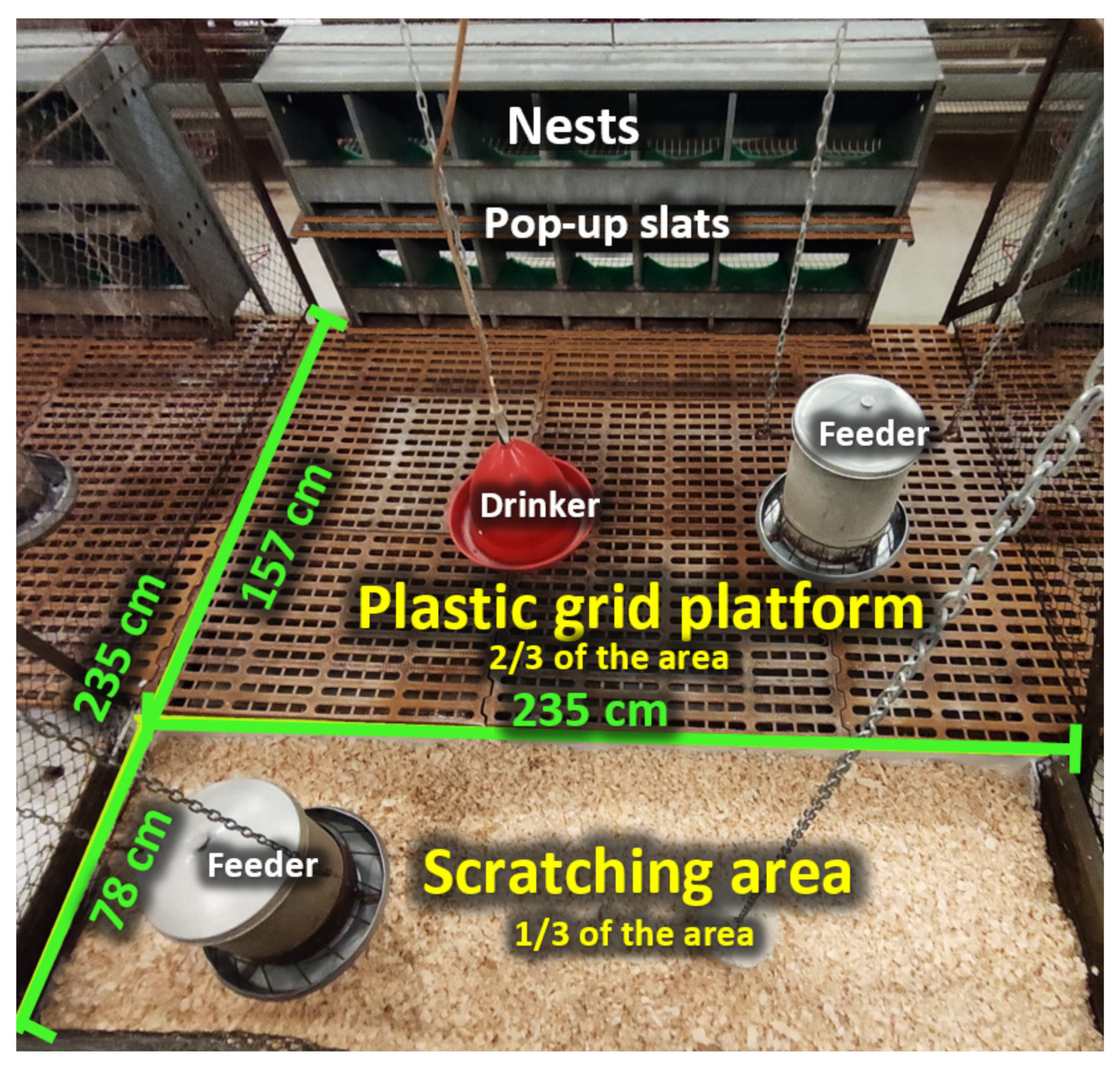

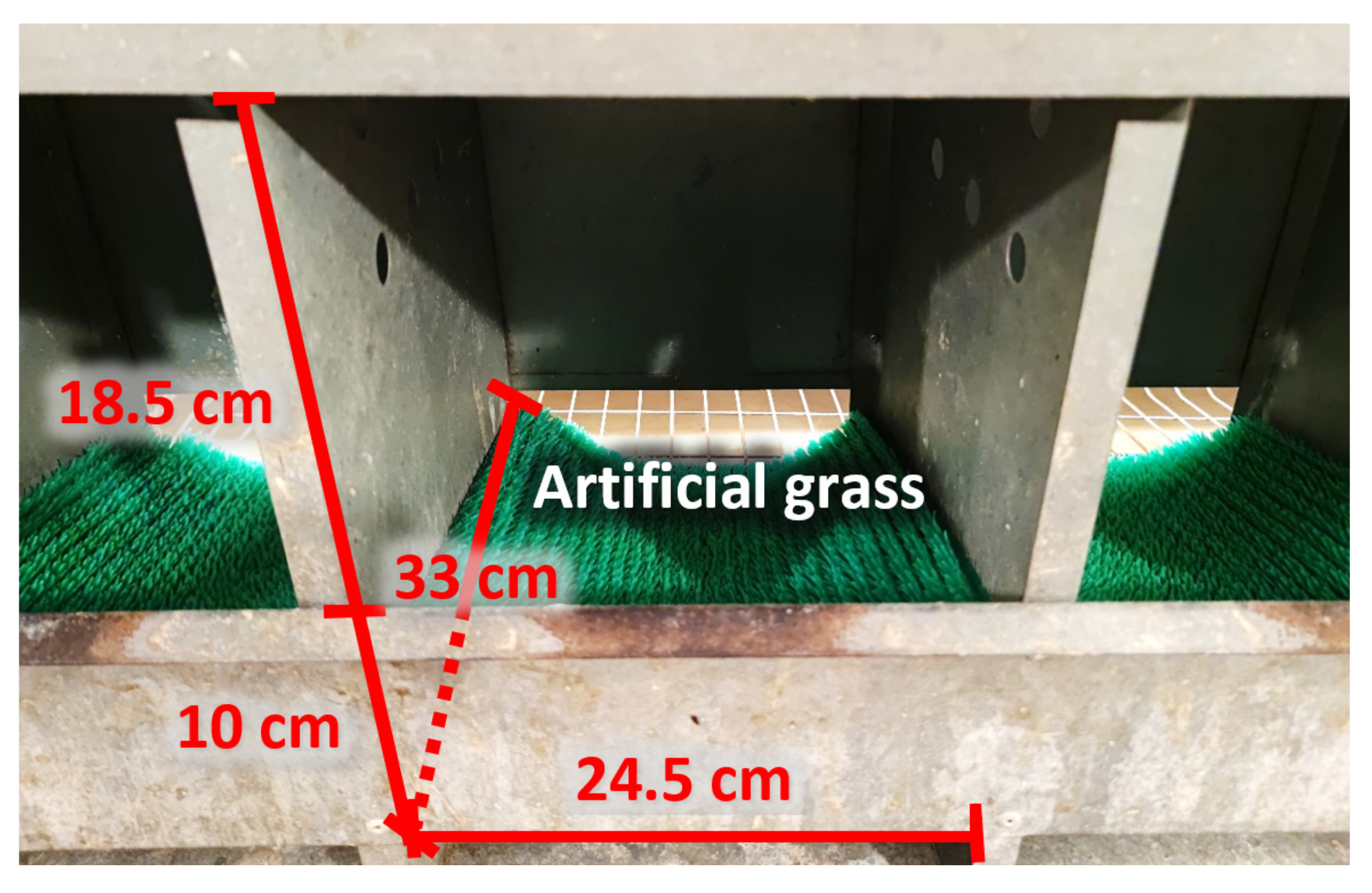
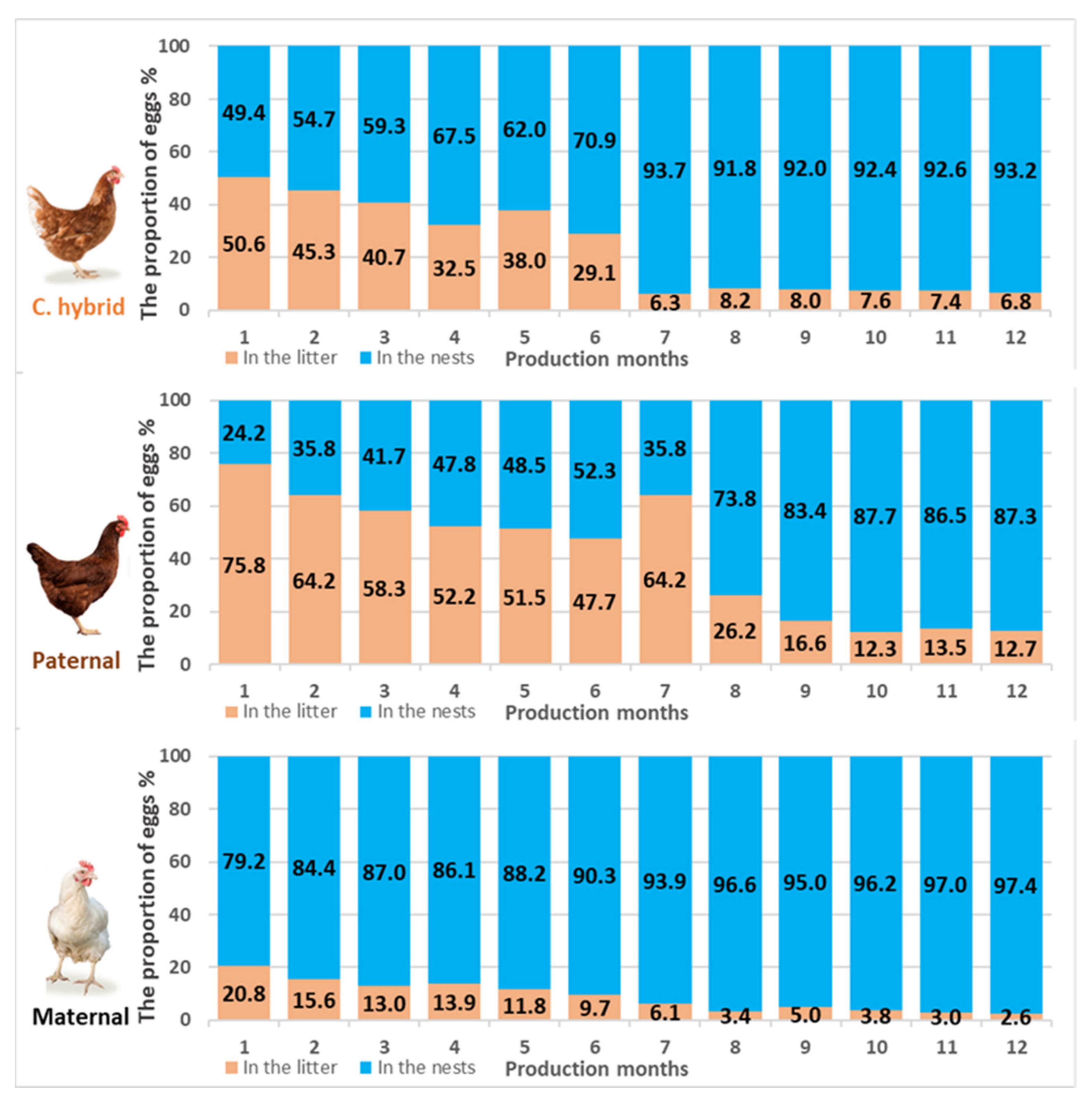
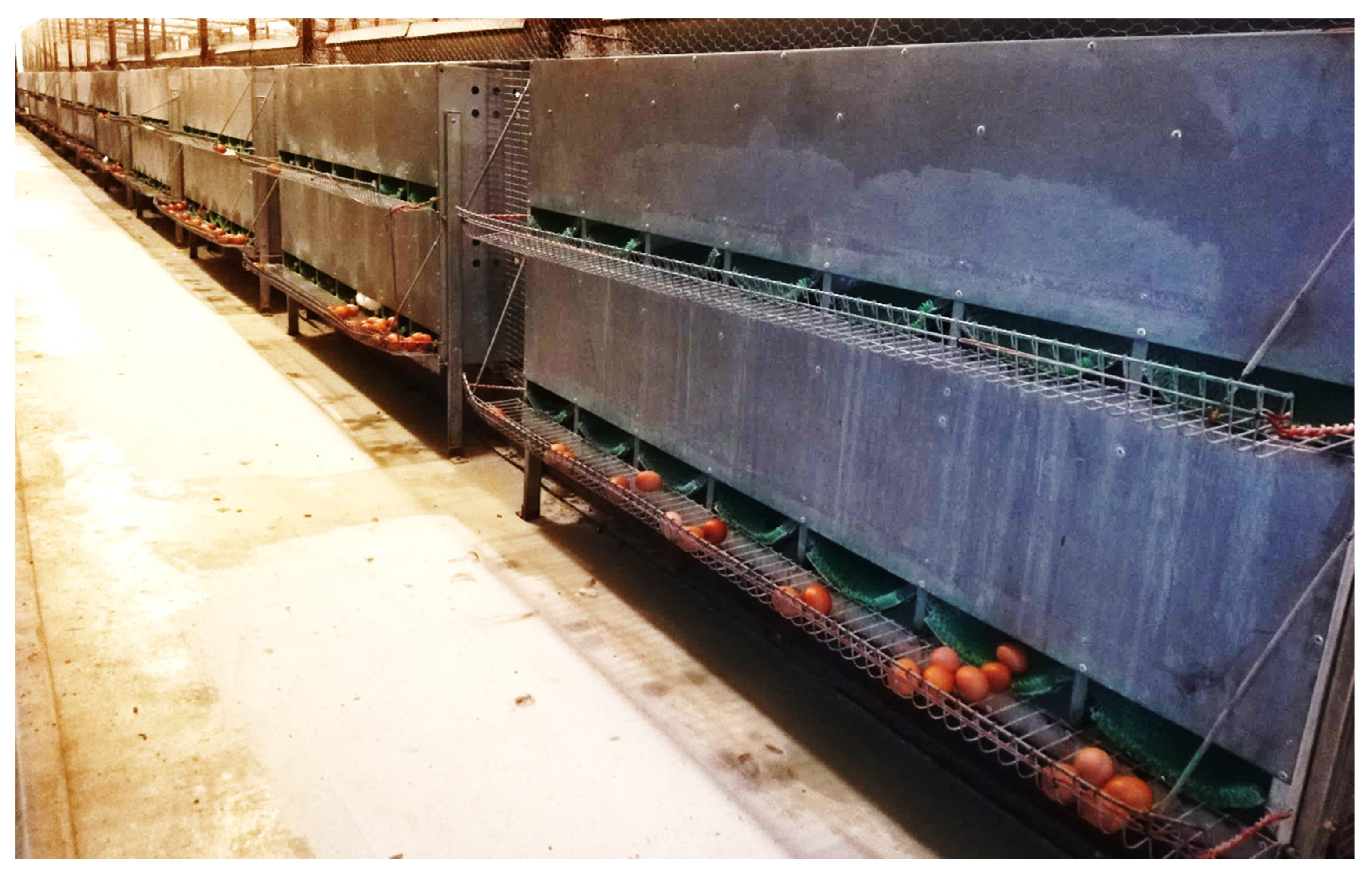
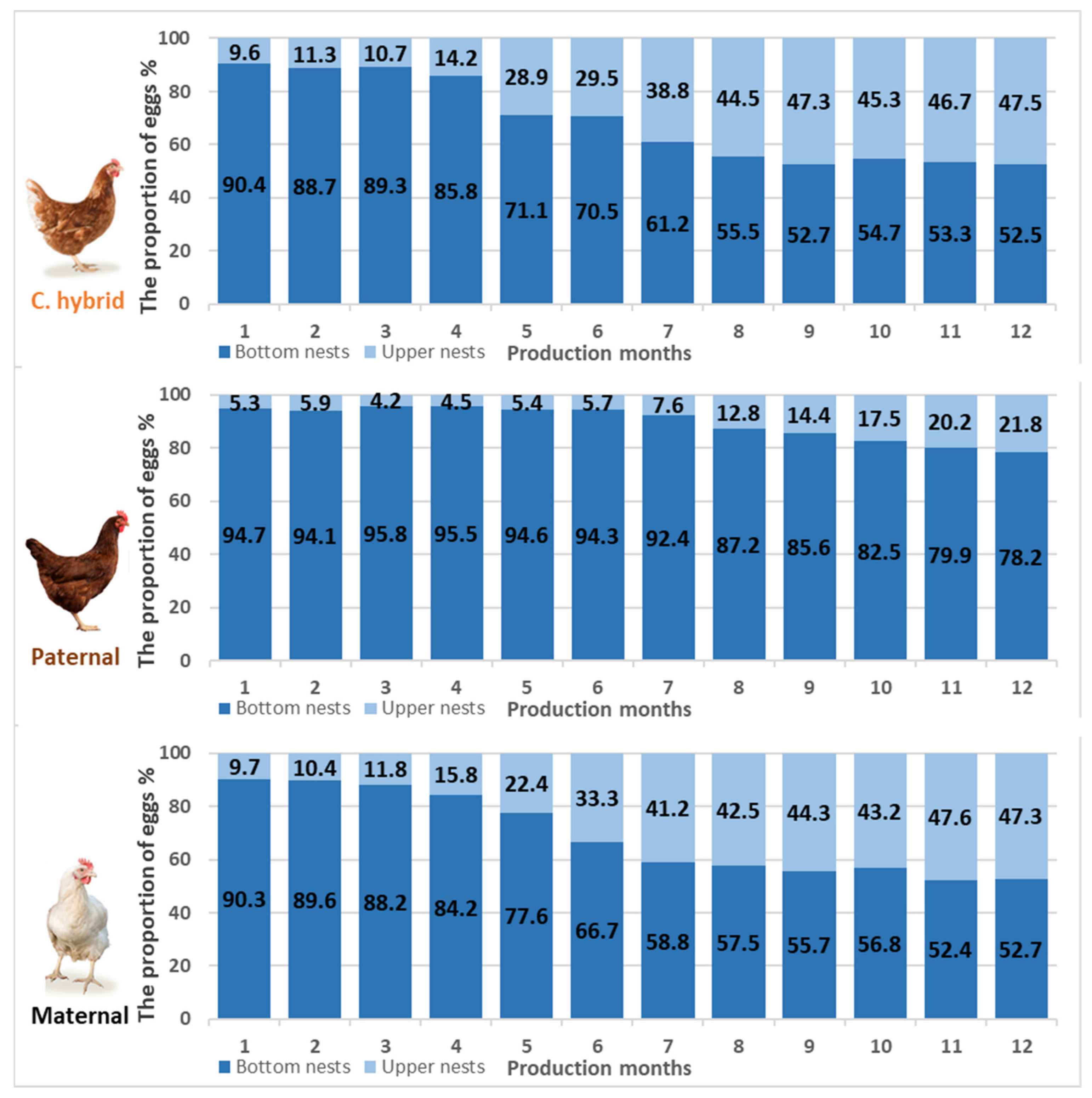
| Genotypes | Distribution of Eggs (%) | ||
|---|---|---|---|
| Total in the Nests | Total in the Litter | Prob. | |
| Commercial hybrid | 69.3 b | 30.7 | <0.001 |
| Paternal | 58.9 a | 41.1 | <0.001 |
| Maternal | 89.8 c | 10.2 | <0.001 |
| Prob. | <0.001 | ||
| Genotypes | Distribution of Eggs (%) | ||
|---|---|---|---|
| Bottom Nests | Upper Nests | Prob. | |
| Commercial hybrid | 72.2 b | 27.8 | <0.001 |
| Paternal | 88.0 a | 12.0 | <0.001 |
| Maternal | 71.4 c | 28.6 | <0.001 |
| Prob. | <0.001 | ||
| Distribution of Laying Hens’ Nest Visits per Nest, % | |||||||||
|---|---|---|---|---|---|---|---|---|---|
| Commercial Hybrid | Prob. | Total | |||||||
| Upper Nests | 1 | 2 | 3 | 4 | 5 | 6 | 7 | <0.001 | |
| 0.0 a | 0.0 a | 0.0 a | 0.0 a | 1.1 a | 0.6 a | 1.1 a | 2.8 A (5) | ||
| Bottom Nests | 8 | 9 | 10 | 11 | 12 | 13 | 14 | ||
| 29.1 c | 12.8 b | 8.9 b | 13.4 b | 12.8 b | 10.6 b | 9.5 b | 97.2 (174) | ||
| Prob. | - | - | - | - | - | - | - | <0.001 | |
| Paternal | |||||||||
| Upper Nests | 1 | 2 | 3 | 4 | 5 | 6 | 7 | <0.001 | |
| 1.0 a | 0.0 a | 0.0 a | 0.0 a | 1.0 a | 0.0 a | 2.0 a | 4.0 A (4) | ||
| Bottom Nests | 8 | 9 | 10 | 11 | 12 | 13 | 14 | ||
| 15.8 b | 12.9 b | 11.9 b | 9.9 b | 16.8 b | 18.8 b | 9.9 b | 96.0 (97) | ||
| Prob. | - | - | - | - | - | - | - | <0.001 | |
| Maternal | |||||||||
| Upper Nests | 1 | 2 | 3 | 4 | 5 | 6 | 7 | <0.001 | |
| 9.6 c | 9.6 c | 2.4 b | 2.4 b | 2.4 b | 0.0 a | 2.4 b | 27.5 B (46) | ||
| Bottom Nests | 8 | 9 | 10 | 11 | 12 | 13 | 14 | ||
| 15.0 c | 10.8 c | 9.0 c | 10.2 c | 8.4 c | 9.0 c | 10.2 c | 72.5 (121) | ||
| Prob. | - | - | - | - | - | - | - | - | <0.001 |
| Prob. | - | - | - | - | - | - | - | - | <0.001 |
| Duration of Nest Visits by Laying Hens per Nest (minutes) | ||||||||
|---|---|---|---|---|---|---|---|---|
| Commercial Hybrid | Combined Average | |||||||
| Upper Nests | 1. | 2. | 3. | 4. | 5. | 6. | 7. | Upper Nests |
| - | - | - | - | 1.3 | 1.0 | 0.5 | 0.9 | |
| Bottom Nests | 8. | 9. | 10. | 11. | 12. | 13. | 14. | Bottom Nests |
| 8.0 | 7.1 | 4.6 | 11.1 | 8.0 | 9.1 | 4.6 | 7.9 a | |
| Prob. | - | - | - | - | - | - | - | 0.266 |
| SE | - | - | - | - | - | - | - | 1.028 |
| Paternal | ||||||||
| Upper Nests | 1. | 2. | 3. | 4. | 5. | 6. | 7. | Upper Nests |
| 5.1 | - | - | - | 38.7 | - | 13.5 | 17.7 | |
| Bottom Nests | 8. | 9. | 10. | 11. | 12. | 13. | 14. | Bottom Nests |
| 14.4 | 5.7 | 9.3 | 7.6 | 19.3 | 17.8 | 11.1 | 13.4 b | |
| Prob. | - | - | - | - | - | - | - | 0.703 |
| SE | - | - | - | - | - | - | - | 2.160 |
| Maternal | ||||||||
| Upper Nests | 1. | 2. | 3. | 4. | 5. | 6. | 7. | Upper Nests |
| 25.3 | 4.2 | 7.1 | 4.4 | 1.3 | - | 2.0 | 7.4 | |
| Bottom Nests | 8. | 9. | 10. | 11. | 12. | 13. | 14. | Bottom Nests |
| 7.3 | 2.8 | 6.1 | 10.3 | 7.6 | 18.1 | 7.7 | 8.6 a | |
| Prob. | - | - | - | - | - | - | - | 0.894 |
| SE | - | - | - | - | - | - | - | 1.052 |
| Prob. | - | - | - | - | - | - | - | 0.018 |
| SE | - | - | - | - | - | - | - | 0.812 |
Publisher’s Note: MDPI stays neutral with regard to jurisdictional claims in published maps and institutional affiliations. |
© 2022 by the authors. Licensee MDPI, Basel, Switzerland. This article is an open access article distributed under the terms and conditions of the Creative Commons Attribution (CC BY) license (https://creativecommons.org/licenses/by/4.0/).
Share and Cite
Farkas, T.P.; Szász, S.; Orbán, A.; Mezőszentgyörgyi, D.; Pető, L.; Sütő, Z. Examination of Nesting Behavior of Laying Hens of Different Genotypes Housed in Indoor Alternative Pens Using a Video System. Appl. Sci. 2022, 12, 9093. https://doi.org/10.3390/app12189093
Farkas TP, Szász S, Orbán A, Mezőszentgyörgyi D, Pető L, Sütő Z. Examination of Nesting Behavior of Laying Hens of Different Genotypes Housed in Indoor Alternative Pens Using a Video System. Applied Sciences. 2022; 12(18):9093. https://doi.org/10.3390/app12189093
Chicago/Turabian StyleFarkas, Tamás Péter, Sándor Szász, Attila Orbán, Dávid Mezőszentgyörgyi, Lilla Pető, and Zoltán Sütő. 2022. "Examination of Nesting Behavior of Laying Hens of Different Genotypes Housed in Indoor Alternative Pens Using a Video System" Applied Sciences 12, no. 18: 9093. https://doi.org/10.3390/app12189093
APA StyleFarkas, T. P., Szász, S., Orbán, A., Mezőszentgyörgyi, D., Pető, L., & Sütő, Z. (2022). Examination of Nesting Behavior of Laying Hens of Different Genotypes Housed in Indoor Alternative Pens Using a Video System. Applied Sciences, 12(18), 9093. https://doi.org/10.3390/app12189093





